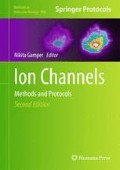Abstract
Mechanotransduction, the conversion of a mechanical stimulus into a biological response, constitutes the basis of a variety of physiological functions such as the senses of touch, balance, proprioception, blood pressure, and hearing. In vertebrates, mechanosensation is mediated by mechanosensory neurons, whose cell bodies are located in trigeminal and dorsal root ganglia. Here, we describe an in vitro model of mechanotransduction that provides an opportunity to explore the properties of mechanosensitive channels in mammalian sensory neurons. The mechano-clamp method allows applying local force on plasma membrane of whole-cell patch-clamped sensory neurons. This technique uses a mechanical probe driven by a computer-assisted piezoelectric microstage to repeatedly stimulate sensory neurons with accurate control of stimulus strength, duration, and speed.
Access this chapter
Tax calculation will be finalised at checkout
Purchases are for personal use only
References
Delmas P, Hao J, Rodat-Despoix L (2011) Molecular mechanisms of mechanotransduction in mammalian sensory neurons. Nat Rev Neurosci 12:139–153
Basbaum AI, Bautista DM, Scherrer G, Julius D (2009) Cellular and molecular mechanisms of pain. Cell 139:267–284
Lumpkin EA, Caterina MJ (2007) Mechanisms of sensory transduction in the skin. Nature 445:858–865
McCarter GC, Reichling DB, Levine JD (1999) Mechanical transduction by rat dorsal root ganglion neurons in vitro. Neurosci Lett 273:179–182
Hao J, Delmas P (2011) Recording of mechanosensitive currents using piezoelectrically driven mechanostimulator. Nat Protoc 6:979–990
Cummins TR, Rush AM, Estacion M, Dib-Hajj SD, Waxman SG (2009) Voltage-clamp and current-clamp recordings from mammalian DRG neurons. Nat Protoc 4:1103–1112
Davie JT, Kole MH, Letzkus JJ, Rancz EA, Spruston N, Stuart GJ, Hausser M (2006) Dendritic patch-clamp recording. Nat Protoc 1:1235–1247
Drew LJ, Wood JN, Cesare P (2002) Distinct mechanosensitive properties of capsaicin-sensitive and -insensitive sensory neurons. J Neurosci 22:RC228
Hao J, Delmas P (2010) Multiple desensitization mechanisms of mechanotransducer channels shape firing of mechanosensory neurons. J Neurosci 30:13384–13395
Coste B, Crest M, Delmas P (2007) Pharma-cological dissection and distribution of NaN/Nav1.9, T-type Ca2+ currents, and mechanically activated cation currents in different populations of DRG neurons. J Gen Physiol 129:57–77
Coste B, Mathur J, Schmidt M, Earley TJ, Ranade S, Petrus MJ, Dubin AE, Patapoutian A (2010) Piezo1 and Piezo2 are essential components of distinct mechanically activated cation channels. Science 330:55–60
Coste B, Xiao B, Santos JS, Syeda R, Grandl J, Spencer KS, Kim SE, Schmidt M, Mathur J, Dubin AE, Montal M, Patapoutian A (2012) Piezo proteins are pore-forming subunits of mechanically activated channels. Nature 483: 176–181
Rugiero F, Drew LJ, Wood JN (2010) Kinetic properties of mechanically activated currents in spinal sensory neurons. J Physiol 588:301–314
Hu J, Lewin GR (2006) Mechanosensitive currents in the neurites of cultured mouse sensory neurones. J Physiol 577:815–828
McCarter GC, Levine JD (2006) Ionic basis of a mechanotransduction current in adult rat dorsal root ganglion neurons. Mol Pain 2:28
Acknowledgments
This work was supported by the CNRS and by grants from the Agence Nationale de la Recherche, Fondation Schlumberger, ARCInca-2006, UPSA, IRME, and Fondation pour la Recherche Médicale.
Author information
Authors and Affiliations
Editor information
Editors and Affiliations
Rights and permissions
Copyright information
© 2013 Springer Science+Business Media, LLC
About this protocol
Cite this protocol
Hao, J., Ruel, J., Coste, B., Roudaut, Y., Crest, M., Delmas, P. (2013). Piezo-Electrically Driven Mechanical Stimulation of Sensory Neurons. In: Gamper, N. (eds) Ion Channels. Methods in Molecular Biology, vol 998. Humana Press, Totowa, NJ. https://doi.org/10.1007/978-1-62703-351-0_12
Download citation
DOI: https://doi.org/10.1007/978-1-62703-351-0_12
Published:
Publisher Name: Humana Press, Totowa, NJ
Print ISBN: 978-1-62703-350-3
Online ISBN: 978-1-62703-351-0
eBook Packages: Springer Protocols

